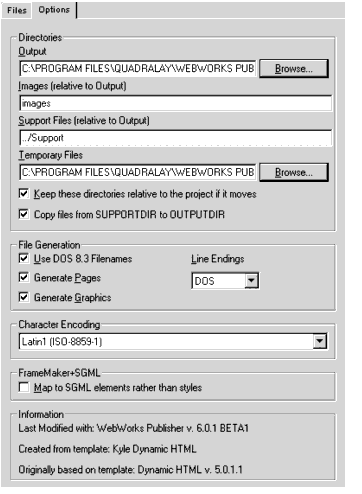|
Setting Options and Preferences
|


Setting project options
The Options tab of the Publisher Project window displays general information about the project and lets you set the following:
- The directories used for output, image, support, and temporary files
- File generation options and whether long filenames are allowed
- Character encoding mapping
- SGML mapping
To view these settings, from the main Publisher Project window, click the Options tab.

| Note: |
The entire Options tab may not be initially visible. To view the whole tab, maximize the window. You may also have to increase your monitor's resolution. |
The following sections describe each set of options in this tab.
Setting project directories
To set the location of the current project's output, images, support, and temporary files, go to the Directories section of the Options tab and set one or more of the following options:
- To specify where generated output files are stored, click the Browse button and select the directory from the Select Output Directory dialog box. If you don't want a separate output directory created, click the Browse button and select the project directory.
- To specify where generated graphics files are stored, type the name of the output directory. For example, if the Images directory is located at the same level as the output files directory, the relative path would be ../images. By default, the images directory is located within the project's output directory. If you want graphics files stored in the same directory as other output files, leave the field blank.
- Support Directory Options
- To specify where support files (graphics and page documents used to create output files) are stored, type the path name relative to the output directory. By default, the support directory is located within the project directory at the same level as the output directory.
- To specify where temporary files (copies of FrameMaker source documents and other files WebWorks Publisher Standard Edition creates as a project is generated) are stored, click the Browse button and select the directory from the Select Temporary Files Directory dialog box.
Setting relative directory structure
- By default, WebWorks Publisher Standard Edition maintains its relative directory structure if a project is moved. To change this setting, deselect the Keep these directories relative to the project if it moves check box. This means that the Output, Images, Support, and Temp directories would not move if you move the project file. By keeping directory relativity intact, you let WebWorks Publisher Standard Edition easily locate all of the files it needs. When Publisher cannot find the files, you will be prompted to supply the file locations when the project is opened.
- If you need to move your projects to other computers or file systems, then you should keep this setting selected.
Setting support files options
- By default, files in the support directory (such as navigation graphics or page formatting files) are copied automatically to the output directory when you generate the project. To change this setting, deselect the Copy files from SUPPORTDIR to OUTPUTDIR check box.
Setting file generation options
To set how Publisher names files and whether it generates output pages and graphics for the project, follow these steps:
- If you want Publisher to use DOS 8.3 file naming, select the Use DOS 8.3 Filename check box. DOS 8.3 file naming limits all file names to eight characters and their extensions to three. If the current file name or extension contain more characters than allowed, the name is truncated. If the check box is not selected, long file names are permitted.
- By default, when a Publisher project is generated, it produces output documents and processes (converts) graphics. If you do not want output documents generated, deselect the Generate pages check box. If you do not want graphics processed, deselect the Generate graphics check box.
- To select whether carriage returns and line endings in output files use DOS, UNIX, or Macintosh format, select the format from the Line Endings Format drop-down list.
Setting character encoding
To set the default language encoding for the current project, select an option from the Character Encoding drop-down list. Available options are as follows:
- Latin1 (ISO-8859-1)
- Unicode (UTF-8)
- Japanese Character Set (SHIFT_JIS)
- Korean Character Set (EUC-KR)
- Simplified Chinese Character Set (GB2312)
- Traditional Chinese Character Set (Big5)
| Note: |
For standard and symbol fonts, choose Latin1. If your document contains multiple languages, choose Unicode. |
Setting FrameMaker+SGML options
If you produced your source files using FrameMaker+SGML and want to use SGML elements instead of paragraph and character tags for mapping, select the FrameMaker+SGML check box. Publisher ignores this option when processing non-SGML files.
Viewing project information
The Information section of the Options tab identifies a project's origins. Publisher automatically sets these values when a new project is created; you cannot modify these settings.



Quadralay Corporation
http://www.webworks.com
Voice: (512) 719-3399
Fax: (512) 719-3606
sales@webworks.com
|
